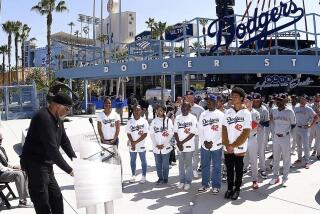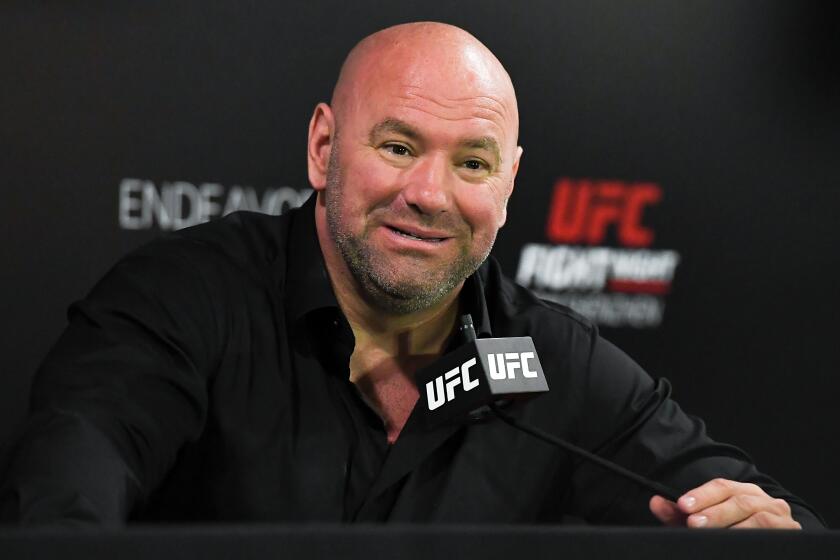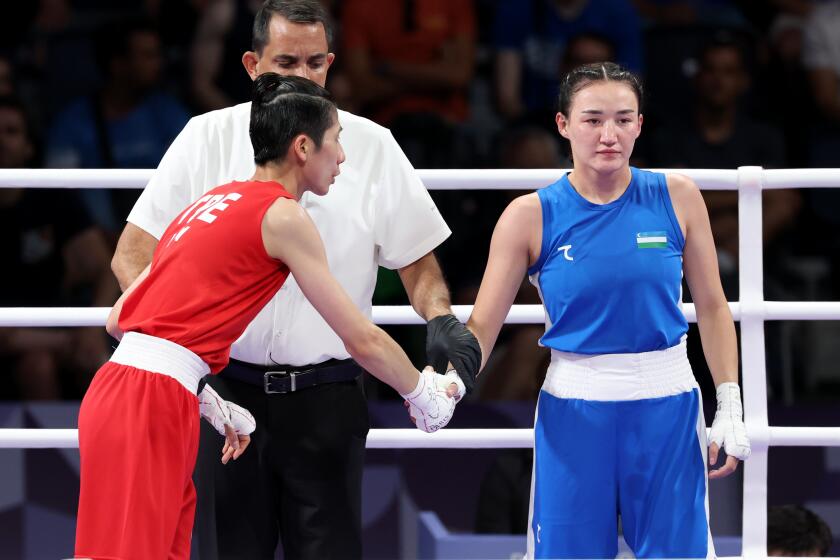THE DAY BROWN BOMBER ARRIVED : 50 Years Ago, Joe Louis Began the Longest Reign
Fifty years ago today, a champion was crowned. And boxing, for all the power and promise of young Mike Tyson, is still waiting to see his like again.
Joe Louis, at 23 years and 1 month, knocked James J. Braddock, a rusty, over-the-hill champion, unconscious in the eighth round at Chicago’s Comiskey Park. From that date until Louis relinquished the title when he retired in 1949, he defended the championship successfully 25 consecutive times.
It’s a record, 25 defenses. And his reign was interrupted for most of three years by a war. Larry Holmes came close with 21 defenses. Muhammad Ali had 19. But 25 defenses of the heavyweight championship remains the record.
If Tyson, today’s heavyweight champion, continues to fight and win at his present pace, he will reach his 25th defense in the early 1990s, possibly before he turns 25.
The Louis reign that began half a century ago tonight, ended 11 years and 8 months later. He attempted a comeback in 1950, but was knocked back into retirement in 1951 by Rocky Marciano.
June 22, 1937:
You could buy a four-bedroom house in Beverly Hills for $22,000. A 15-unit Beverly Hills apartment building was on the market for $85,000. Earle C. Anthony was selling new Packards in Los Angeles for $1,404.
If you bought it at the Detroit factory, a new ’37 Ford V-8 “60” sold for $533. First-class Matson Line fare to Honolulu was $125. May Co. was advertising men’s suits for $16.75. Top sirloin steak at Ralph’s supermarkets cost 31 a pound.
And Joe Louis made $115,125.
All over America, boxing gymnasiums were full of street kids, imbued with the desire to earn the kind of paychecks Louis was earning. Never in American sports had an athlete risen so quickly to the big money in professional sports as Louis had.
Joe Louis started 1933 as a cabinetmaker’s apprentice and by the end of the year was earning a dollar a day at Detroit’s Briggs’ Auto Body Works.
By late 1934--less than a year after he had turned pro--he was earning $1,000 a fight. In Depression America, what Louis earned was as newsworthy as how he earned it.
Except for the electrifying rise of Louis, boxing’s heavyweight division was in a sad state in 1937. The champion, Braddock, who had won the title in 1935 on an upset decision over Max Baer, had not defended the championship for more than two years, when he fought Louis.
A 6-foot 7-inch Italian circus strong man, Primo Carnera, was masquerading as a contender. Max Schmeling, the German champion who had upset Louis in 1936, had a contract to fight Braddock, but Braddock sought the bigger pay day Louis would bring.
Boxing promoter Mike Jacobs booked the title fight for Comiskey Park, and the New York State Athletic Commission threatened a lawsuit. It ordered Schmeling into training to meet Braddock. Later, Schmeling actually showed up alone for a weigh-in for a Braddock fight, days before Braddock and Louis met.
In Braddock, Louis was facing a popular, though inactive, champion who also had risen from Depression poverty.
A one-time New York dock worker, Braddock, with a wife and three small children, had been broke and on relief in 1933. Americans liked him. He was Irish-American, had a bent nose, wore short-billed caps. Somehow he typified young American men, down on their luck, in the 1930s.
Braddock, who’d quit school at 13, had to borrow money from his manager, Joe Gould, to prevent his electricity from being turned off in 1934. He swung a pick on a road gang.
Louis was born in a sharecropper’s shack in the Buckalew Mountain country of Chambers County, Ala., in 1914.
Two of his grandparents had been slaves. His lineage was white, black and Indian--Creek and Cherokee. He was the fourth child of Lilly and Munroe Barrow, and they named him Joseph Louis Barrow.
A few years later, according to Louis biographer Nat Fleischer, Louis’ father broke from the strain of keeping his family together in hard times and ended up in a mental hospital. Louis’ mother later married Patrick Brooks and the combined families moved to Detroit in 1924.
Years later, Louis’ mother enjoyed showing friends a handwritten note, sent to her from one of Louis’ teachers. It said: “This boy should learn to do something with his hands.”
In his teens, Joe went to vocational school, where at first he wanted to be a furniture maker. At 12, he made a dollar a day on an ice wagon. Later, he made the same wage running a lathe at the Briggs works, until word got out that he could fight.
One day, he walked into Detroit’s Brewster Recreation Center, and put on a pair of gloves. He started boxing as an 18-year-old middleweight and had won more than 50 amateur bouts when he won the national AAU light-heavyweight title in 1934.
When Fleischer covered the 1934 national AAU tournament in St. Louis, he wrote in his Ring magazine story that Louis “is the most promising heavyweight prospect since my discovery of Max Schmeling, in Hamburg, in 1926.”
Louis seemed to get higher paying part-time jobs as his fame as an amateur boxer spread. He was given $25 gift certificates for winning bouts, which he turned over to his mother. But he couldn’t help but notice that inferior pro heavyweights were getting $25 cash for bouts in the Detroit area.
John Roxborough, a Detroit lawyer who had followed Louis’ progress, finally decided in 1934 that Louis was ready to turn pro. His co-manager was Julian Black. The trainer was Jack (Chappie) Blackburn.
They booked his pro debut at a Chicago night spot called the Bacon Casino, on the city’s South Side. On July 4, 1934, he knocked out Jack Kracken in the first round. His purse was $59. His debut rated one-paragraph items in the Chicago and Detroit sports sections the next morning. Four months later, he went over the $1,000-a-fight mark.
Less than a year later, on June 25, 1935, he knocked out Carnera in Yankee Stadium and earned $44,636.16. And three months after the Carnera fight, he had a monster payday, $240,833, for beating Max Baer.
Just when everyone was wondering if anyone out there could beat the 6-foot 1-inch, 200-pound Louis, someone did. Schmeling caught Louis early with a big right hand in their fight in New York June 19, 1936, and finally knocked him out in the 12th round, ending Louis’ streak of 27 straight wins.
Louis would get another chance at Schmeling, and win. But on June 22, 1937, the heavyweight championship of the world was within his grasp. He’d won 11 in a row since the Schmeling upset. A Comiskey Park crowd of 45,500 paid $749,935 that night, the eighth-biggest gate in boxing history at the time. Louis earned $115,125, Braddock $296,690.
The promoter, Mike Jacobs, knew that Braddock had virtually no chance to beat Louis. But to hype the gate, he waged a successful prefight publicity campaign, saying how wonderful the 31-year-old Braddock looked in training and how out-of-shape and uninspired Louis looked. Louis came in at 197, Braddock at 197. Louis was a 3-1 favorite, but fought like a 100-1 favorite.
According to Louis biographer Chris Mead in his 1985 book, “Champion--Joe Louis, Black Hero in White America,” Louis’ trainer, Blackburn, turned to Louis in his corner during the introduction of ringside celebrities, and said to the fighter: “This is it, Chappie. You come home a champ tonight.”
Braddock knocked Louis down briefly with a short right uppercut in the first round. After that, Louis slowly, inexorably turned the contest into a mismatch.
He won the championship in the eighth round, with a right hand that knocked Braddock unconscious. Braddock’s bleeding face was on the canvas when referee Tommy Thomas counted him out. His handlers had to carry him to his corner. Later, Braddock’s face needed 23 stitches.
The overmatched Braddock went out with his boots on, fists flying, and reporters went overboard, citing numerous references to Braddock’s courage. Game to the end, they wrote. Louis, by contrast, was called savage, vicious and murderous.
Louis was the first black heavyweight champion in 22 years, and some sports journalists weren’t happy about it. In columns, the New York Times’ John Kieran frequently referred to Louis as “Shufflin’ Joe.” Reporters called Louis “Dusky Joe,” “The Black Cyclone,” or, most commonly, “the Negro.”
The L.A. Times’ Jack Singer, assigned to write a piece about the historical significance of Louis’ victory, began with these two paragraphs:
“Up in Heaven’s Harlem where the watermelons grow ice cold right on Lennox Ave. and the pork chops and fried chicken blossom on bushes and are just a’ itchin’ to be plucked right off your front porch they are a’shoutin’ and a’singin’ “Hallalujah” because ain’t Joe Louis the heavyweight champion of the entire world.
“Sho’ nuf, there are some great colored boxing gen’mun rejoicing up there where the galloping dominoes speak nothing but “seben and eleben” and the old rockin’ chairs just sway to and fro without a lazy culud man ever a’havin’ to twitch his toes . . . “ That was 10 years before Jackie Robinson broke baseball’s color barrier. In 1937, America’s prominent black athletes could sit at a table for two: Joe Louis and Jesse Owens.
But Louis’ reign had arrived. He defended the championship 22 times before he entered the Army in 1942, then boxed in 96 military exhibition bouts aboard ships in the Pacific and at U.S. bases in Europe and North Africa--at sergeant’s pay.
Louis was a big spender and during the war he borrowed heavily from promoter Mike Jacobs against future purses, debts that overwhelmed him in a few years.
In 1946, Louis met Billy Conn in one of the most anticipated sports events of the decade. In 1941, as a 169-pound challenger, Conn had easily outboxed Louis for 12 rounds and seemingly had victory well in hand. Then, trying for a knockout, he got careless. Louis knocked him out.
Five years later, Louis wasn’t the same fighter. But neither was Conn. Louis, on his biggest payday, knocked out Conn in the eighth. The champion’s purse was $625,916.
Louis next defeated Tami Mauriello, then added two wins over Jersey Joe Walcott--the first on a highly disputed decision--in 1947 and 1948. He retired in 1949 but began a 10-fight comeback in 1950. He quit for good after Rocky Marciano knocked him out in 1951.
Through the 1950s, he battled the Internal Revenue Service over back taxes, penalties and interest charges that mounted daily. He once joked to a friend: “It costs me $250 just to get up in the morning.”
In 1951, his growing tax bill was about $500,000. According to author Mead, when Louis’ mother died in 1953 and left him $667, the Internal Revenue Service took it.
In 1956, the ultimate disgrace: Louis went on the pro wrestling circuit in a pathetic attempt to catch up to his tax debt.
The government finally forgave Louis’ immense tax debt, closing the books on his case in 1960.
He spent his last years in Las Vegas, where for much of the time he was a greeter at Caesars Palace. His health was poor in his final years. He died of a heart attack April 12, 1981, the day after he had sat at ringside in a wheelchair to watch the Larry Holmes-Trevor Berbick fight. He was 66.
Braddock fought once more after losing his championship, winning a 1938 decision over England’s Tommy Farr. He went into the Ring record book as the man Louis defeated for the heavyweight championship, as well as the man who pulled off one of boxing’s all-time upsets in winning it. When he beat Max Baer on a decision for the title in 1935, he was a 10-1 underdog.
Although Braddock had been wiped out financially in the Depression and wound up on the relief rolls, he became a prosperous businessman in later life. After serving as a captain in the Army Transportation Corps in the Pacific in World War II, he returned home and developed a successful marine supply business in North Bergen, N.J. He was 68 when he died there on Nov. 29, 1974.
More to Read
Go beyond the scoreboard
Get the latest on L.A.'s teams in the daily Sports Report newsletter.
You may occasionally receive promotional content from the Los Angeles Times.










